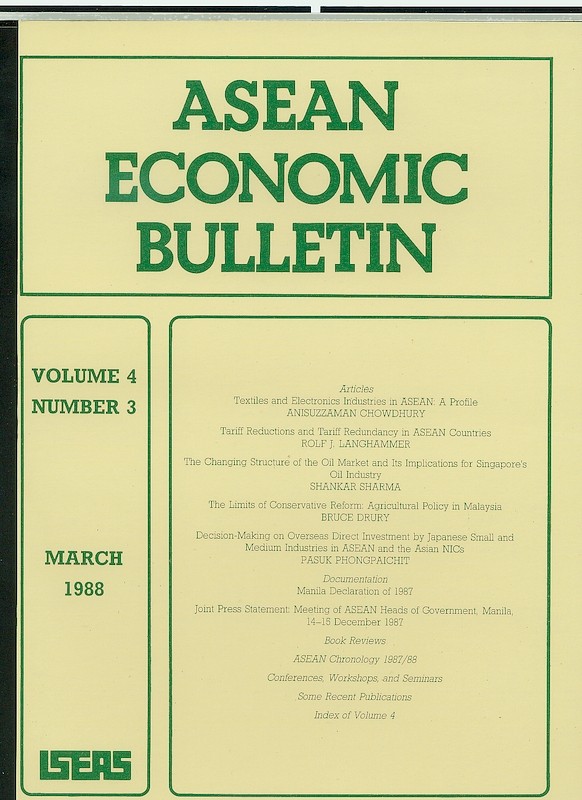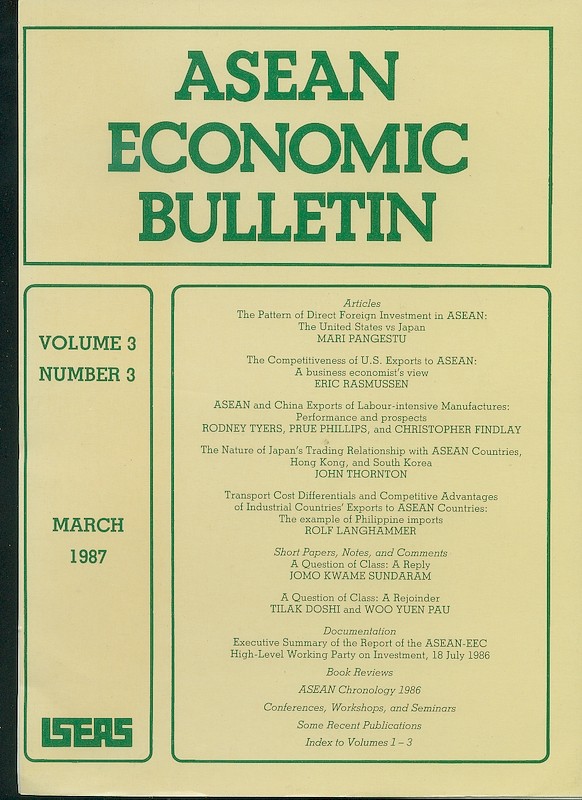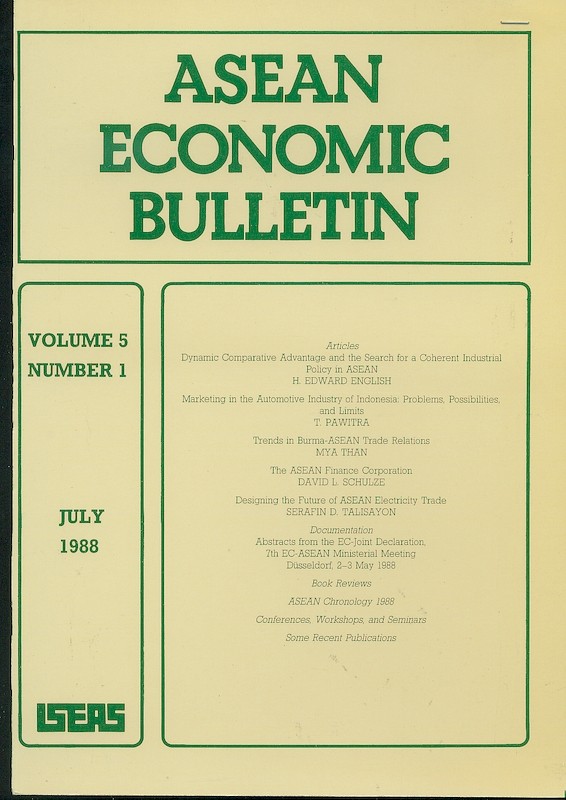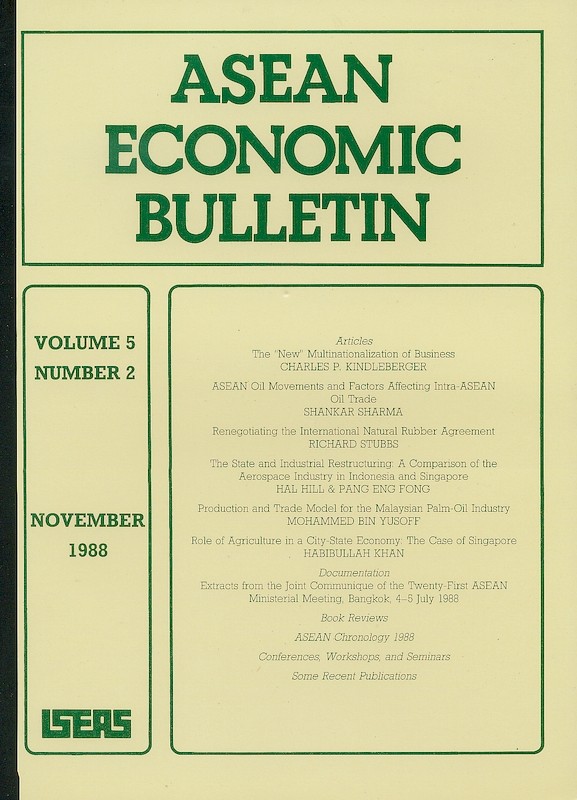ASEAN Economic Bulletin Vol. 4/2 (Nov 1987)
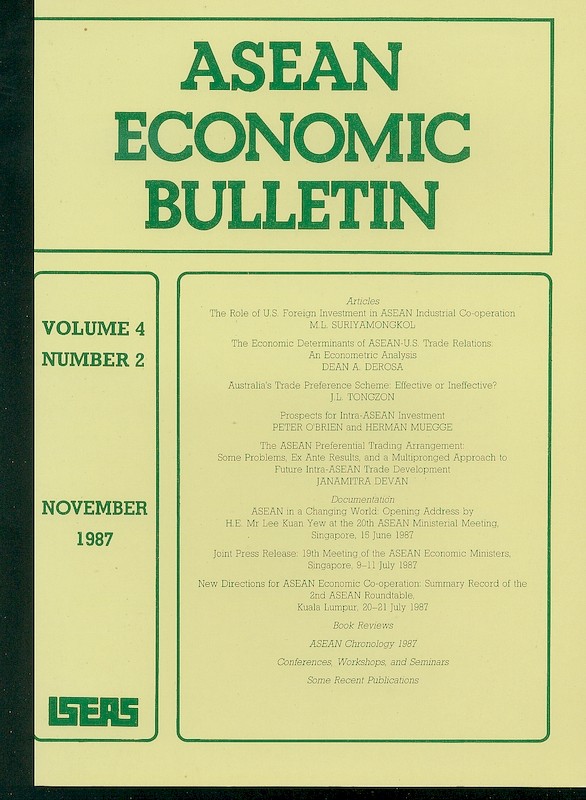
Date of publication:
November 1987
Number of pages:
107
Code:
AE4/2
Contents
-
Preliminary pages
- ARTICLES
-
The Role of U.S. Foreign Investment in ASEAN Industrial Co-operation, by M L Suriyamongkol, author see abstractThe main focus of this paper is the regional impact of U.S.-ASEAN investment relations: Does U.S. investment complement ASEAN's regional industrial co-operation? Generally, the relationship is asymmetrical since U.S. investment is important for ASEAN countries, but ASEAN is not as important for U.S. investors. Further, Japan's role as a market and host/source of investment places the United States and ASEAN in a triangular relationship. The paper also looks at existing patterns of U.S. investment in five ASEAN countries. Finally, there is analysis of U.S investors role in three techniques of ASEAN co-operation: ASEAN Industrial Projects (AIP), ASEAN Industrial Complementation (AIC), and ASEAN Industrial Joint Ventures (AIJV). The paper concludes that past experience and an international environment of continued economic friction and uncertainty are likely to make ASEAN industrial co-operation of less importance than other U.S.-ASEAN economic relations.
-
The Economic Determinants of ASEAN-U.S. Trade Relations: An Econometric Analysis, by Dean A DeRosa, author see abstractThis paper offers an econometric inquiry into the economic determinants of the commodity composition of trade between the ASEAN countries and the United States, using as a guide the precepts of some modern theories of international trade. It also investigates the association between possible sources of comparative advantage and recent changes of the commodity composition of ASEAN-U.S. trade. Finally, it considers the power of the hypothesized determinants of ASEAN-U.S. trade for explaining variations across commodity categories of the tariff structures enforced by the ASEAN countries and the United States.
-
Australia's Trade Preference Scheme: Effective or Ineffective?, by Jose L Tongzon, author see abstractThis paper assesses the value of Australia's trade preferences for developing countries (ASTP) from the Australian-ASEAN perspective. The methodology adopted is a modified version of Burtt's (1977) due to the selective coverage of the scheme. The evidence seems to indicate the inefficiency of the preferences in substantially increasing Australia's imports of those preferential items (products covered by the scheme) from the ASEAN countries, and thus, raises the issue of whether or not the present scheme should be further modified to accommodate the aspirations of the developing countries.
-
Prospects for Intra-ASEAN Investment, by Kate O'Brien, Herman Muegge, authors see abstractFollowing two decades of operation ASEAN member countries see the organization in a period of increasing challenges. Collaboration on political issues has been fruitful but there is little progress noticeable in the economic sphere. The implicit policy not to move towards the formation of a free trade area, or to aim for more ambitious schemes such as a customs union or a common market, has meant that actual economic co-operation has been confined to limited areas. Among these the issue which has perhaps received most attention is that of industrial investment, specifically the ways of encouraging joint investment among countries of the region. This paper addresses itself to this issue in a broad perspective taking into account the circumstances now facing ASEAN members. It examines the rationale for promoting various forms of joint investment, and the prospects for increasing such activities.
-
The ASEAN Preferential Trading Arrangement: Some Problems, Ex ante Results, and a Multi-pronged Approach to Future Intra-ASEAN Trade Development, by Janamitra Devan, author see abstractThe ASEAN Preferential Trading Arrangement (PTA) was an early effort at regionalized growth in the face of divergent growth strategies of individual member countries. This article attempts to shed some light on the potential of the PTA as currently structured, following the findings of a comparative static ex ante analysis. On the basis of the results found, this research attempts to diagnose how the PTA could be enhanced to make it a more effective tool for greater intra-ASEAN trade. Additionally, other areas such as the ASEAN Industrial Scheme, harmonization policies, and the case of primary commodities are examined in the context of existing problems.
-
DOCUMENTATION: ASEAN in a Changing World: Opening Address by H E Mr Lee Kuan Yew at the 20th ASEAN Ministerial Meeting, Singapore, 15 June 1987
-
DOCUMENTATION: Joint Press Release: 19th Meeting of the ASEAN Economic Ministers, Singapore, 9-11 July 1987
-
DOCUMENTATION: New Directions for ASEAN Economic Co-operation: Summary Record of the 2nd ASEAN Roundtable, Kuala Lumpur, 20-21 July 1987
-
BOOK REVIEWS: ASEAN-Australia Trade in Manufacturers, edited by David Lim, by Amina Tyabji, author
-
BOOK REVIEWS: South-East Asian Seas: Oil Under Troubled Waters, by Mark J Valencia, by Tilak K Doshi, author
-
BOOK REVIEWS: What Britain Pays for Voluntary Export Restraints, by David Greenway and Brian Hindley, by Antal Deutsch, author
-
BOOK REVIEWS: Singapore: Resources and Growth, edited by Lim Chong-Yah and Peter Lloyd, by Antal Deutsch, author
-
ASEAN Chronology 1987
-
Conferences, Workshops, and Seminars
-
Some Recent Publications

